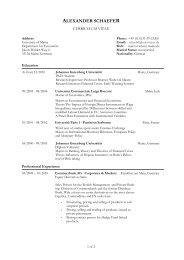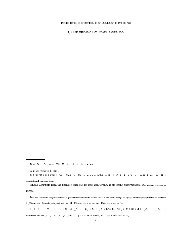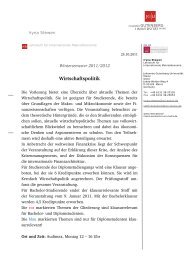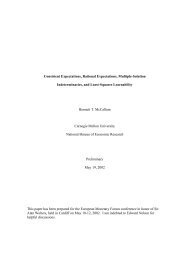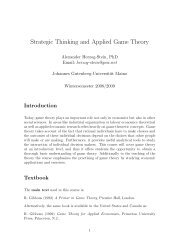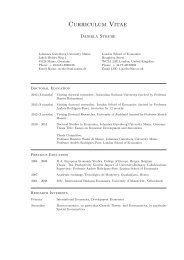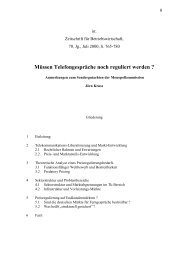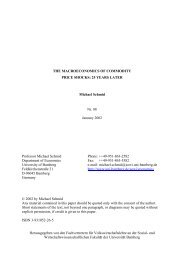Beatrice Weder di Mauro
Beatrice Weder di Mauro
Beatrice Weder di Mauro
Create successful ePaper yourself
Turn your PDF publications into a flip-book with our unique Google optimized e-Paper software.
<strong>Beatrice</strong> <strong>Weder</strong> <strong>di</strong> <strong>Mauro</strong><br />
Professor of International Macroeconomics<br />
SoSe 2010<br />
Department of Economics - FB 03<br />
D-55099 Mainz, Germany<br />
Tel. :+49 (0)6131-3920144<br />
Telefax:+49 (0)6131-3925053<br />
<strong>Beatrice</strong>.<strong>Weder</strong>@uni-mainz.de<br />
24.2./2010<br />
Outline for the bachelor seminar in microfinance<br />
Preliminary session<br />
The preliminary session will take place on Wednesday, April 14 th 2010, 10am-12am, at room RW 6.<br />
Participation is compulsory.<br />
Every student should read through the topics before and choose two priorities. The topics will be<br />
allocated during this preliminary <strong>di</strong>scussion. If the topics cannot be allocated accor<strong>di</strong>ng to the<br />
students priorities, the remaining will be drawn.<br />
Mentoring<br />
Contact person for <strong>di</strong>scussion and questions will be Helke Wälde (helke.waelde@uni-mainz.de). If<br />
you have an appointment, be prepared and able to ask detailed questions.<br />
Exposé<br />
Deadline for the exposé is June 2th 2010, 12 pm. Two copies and a pdf-file must be handed in at the<br />
secretariat. The exposé must be written in English and should be at most 5 pages (incl. cover sheet,<br />
graphs, figures, references, excl. appen<strong>di</strong>x). The exposé will be graded and is part of the final score.<br />
The exposé is a detailed outline of the Bachelor-thesis in written form. For the content it is utmost<br />
important to know the relevant literature. You should not only use the denoted literature but also<br />
research and use the economics literature concerning the topic. The exposé should contain a<br />
motivation for the topic, the main points regar<strong>di</strong>ng the question must be presented in detail, the topic<br />
must be classified into the academic literature and you should deal with the subject critically.<br />
Presentation<br />
The seminar will take place as a block course on<br />
June 11, Room HS VI – from 9am to 4pm .<br />
All participants have compulsory attendance. Each student must give a presentation in English<br />
about his/her topic. The timing for each presentation is 20 minutes. Afterwards, a <strong>di</strong>scussion will take<br />
place. Both the presentation and the participation in the <strong>di</strong>scussion will be part of the final score.<br />
Each student must prepare a PowerPoint presentation to present his/her topic during the seminar.<br />
To present the topic and the questions it is recommended to use graphs, to illustrate examples or to<br />
present data etc.
Bachelor-thesis<br />
It is required to start the Bachelor-thesis during the winter term 2010/11. The time for processing is 8<br />
weeks and the thesis should be at most 20 pages (incl. graphs, tables, excl. references). Please<br />
take notice of the information for Seminar-, Bachelor- and Diploma-thesis on our website.<br />
Literature<br />
Literature announced with the topics is meant to be a starting point. You should not only understand<br />
this article. For a good bachelor thesis, you have to research the topic, find other articles concerning<br />
the topic, build up an own opinion and write this down in your thesis. Use EconLit or other scientific<br />
databases. Google is not sufficient. Articles should not be much older than 10 years. A short<br />
introduction in using EconLit will be given at the preliminary session.<br />
General rea<strong>di</strong>ng:<br />
The Microfinance Revolution, Marguerite Robinson, World Bank, 2001-2002<br />
The Economics of Microfinance, Beatriz Armendariz und Jonathan Morduch, MIT Press, 2007<br />
Topics<br />
I. Social connections and social sanctions in group cre<strong>di</strong>ts<br />
1. The role of social connections for group cre<strong>di</strong>ts<br />
(Karlan, D.S., (2007), „Social connections and group banking“, Economic Journal. 117, F52-F84.)<br />
2. The mechanism from social sanctions in group cre<strong>di</strong>ts<br />
(Besley, T. and S. Coate (1995), „Group len<strong>di</strong>ng, repayment incentives and social collateral“, Journal<br />
of Development Economics, 46, 1-18.)<br />
3. Critiques on Besley/Coate<br />
(Arnold, L., S. E. Steger and J. Reeder (2009),"Microfinance and markets: New results for the<br />
Besley-Coate group len<strong>di</strong>ng model", http://www.wiwi.uni-regensburg.de/arnold/documents<br />
/microcre<strong>di</strong>t_2.pdf?source_opus=476.)<br />
II. Group cre<strong>di</strong>t versus in<strong>di</strong>vidual cre<strong>di</strong>t<br />
4. Overview of mechanism<br />
(Townsend, R. M. (2003), „Microcre<strong>di</strong>t and mechanism design“, Journal of the European Economic<br />
Association, 2/3, 468-477)<br />
5. Empirical evidence<br />
(Gine, X. And D. S. Karlan (2008), „Peer monitoring and enforcement: Long term evidence from<br />
microfinance len<strong>di</strong>ng groups with and without group liability“, http://karlan.yale.edu/p/bulak.pdf)<br />
III. Outreach versus efficiency<br />
6. Subsi<strong>di</strong>es for banks in microfinance<br />
(Morduch, J. (1999), „The role of subsi<strong>di</strong>es ins Microfinance: Evidence from the Grameen Bank.“,<br />
Journal of Development Economics, 60, 229-48)<br />
7. Performance or Outreach<br />
(Cull, R., A. Demirgüc-Kunt, and J. Morduch (2007), „Financial performance and outreach: A Global<br />
analysis of lea<strong>di</strong>ng microbanks.“, The Economic Journal, 117, 107-33.)
8. Should (microfinance) banks help poor people or make profit?<br />
(Hermes, N., R. Lensink, and A. Meesters (2008), „Outreach and effiency of microfinance<br />
institutions“, http://som.eldoc.ub.rug.nl/reports/2008/08002/)<br />
IV. Empirical view on the impact of microfinance on poverty<br />
9. Does microfinance help the poor to get out of poverty?<br />
(Khandker, S. R. (2005), „Microfinance and poverty: evidence using panel data from Bangladesh“,<br />
The World Bank Economic Journal, 19 (2), 263-86.)<br />
10. Do group cre<strong>di</strong>ts help poor woman better than poor man?<br />
(Khandker, S. R. and M. M. Pitt (2003), „The impact of group-based cre<strong>di</strong>t on poor households:<br />
Does the gender of participants matter?“, http://www.jstor.org/stable/2991491?cookieSet=1)



